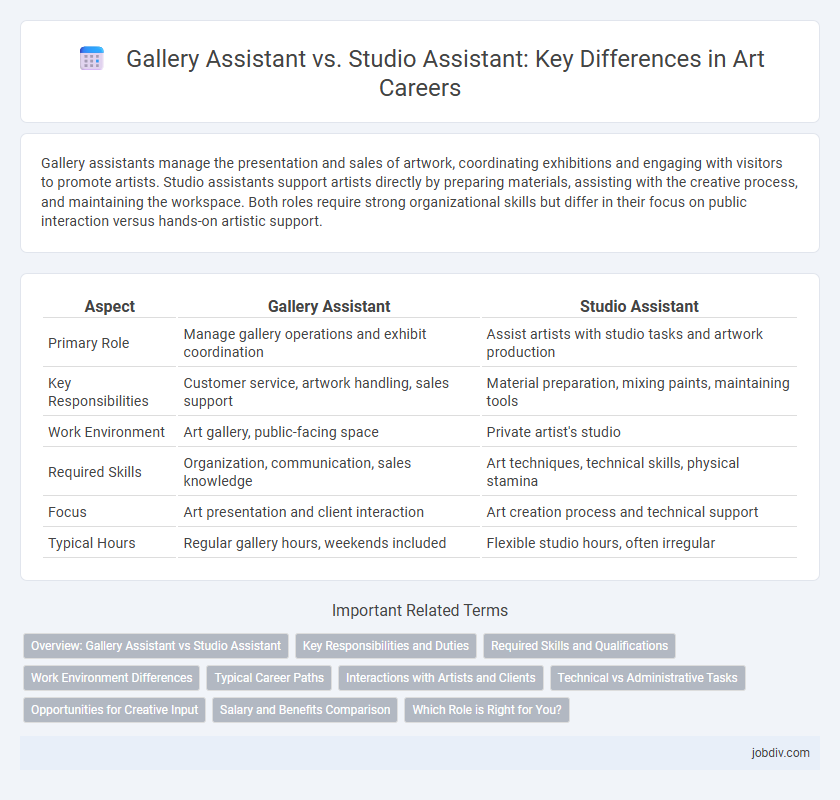Gallery assistants manage the presentation and sales of artwork, coordinating exhibitions and engaging with visitors to promote artists. Studio assistants support artists directly by preparing materials, assisting with the creative process, and maintaining the workspace. Both roles require strong organizational skills but differ in their focus on public interaction versus hands-on artistic support.
Table of Comparison
| Aspect | Gallery Assistant | Studio Assistant |
|---|---|---|
| Primary Role | Manage gallery operations and exhibit coordination | Assist artists with studio tasks and artwork production |
| Key Responsibilities | Customer service, artwork handling, sales support | Material preparation, mixing paints, maintaining tools |
| Work Environment | Art gallery, public-facing space | Private artist's studio |
| Required Skills | Organization, communication, sales knowledge | Art techniques, technical skills, physical stamina |
| Focus | Art presentation and client interaction | Art creation process and technical support |
| Typical Hours | Regular gallery hours, weekends included | Flexible studio hours, often irregular |
Overview: Gallery Assistant vs Studio Assistant
Gallery Assistants manage exhibition logistics, coordinate artist relations, and handle art sales, ensuring smooth gallery operations and customer engagement. Studio Assistants support artists by preparing materials, maintaining studio organization, and assisting in artwork production, facilitating creative processes and productivity. Both roles require strong organizational skills but differ in focus: client interaction and sales for Gallery Assistants versus hands-on artistic support in Studio Assistants.
Key Responsibilities and Duties
A Gallery Assistant manages exhibition logistics, customer interactions, and sales transactions, ensuring smooth gallery operations and promotional activities. In contrast, a Studio Assistant supports artists by preparing materials, organizing tools, and maintaining the workspace to facilitate creative processes. Both roles demand strong organizational skills, but the Gallery Assistant emphasizes public engagement and sales, while the Studio Assistant focuses on behind-the-scenes production support.
Required Skills and Qualifications
Gallery Assistants require strong communication skills, customer service experience, and knowledge of art history to effectively engage with visitors and manage exhibitions. Studio Assistants need technical skills in art materials, familiarity with various artistic techniques, and the ability to support artists through hands-on tasks and studio maintenance. Both roles demand organizational abilities and attention to detail but differ in their focus on public interaction versus behind-the-scenes artistic support.
Work Environment Differences
Gallery Assistants typically work in public-facing environments, managing art exhibits, coordinating gallery events, and interacting with visitors to enhance their experience. Studio Assistants operate in private or semi-private artist studios, providing hands-on support with art creation, materials preparation, and studio maintenance. The gallery setting emphasizes customer service and event management, whereas the studio setting centers on direct artistic collaboration and technical assistance.
Typical Career Paths
Gallery assistants often progress to roles such as gallery manager, art dealer, or art curator, gaining expertise in art sales, exhibition planning, and client relations. Studio assistants typically advance to independent artists, studio managers, or specialized technicians, deepening skills in artistic techniques, art production, and creative collaboration. Both career paths emphasize experience in the art industry but diverge in focus between commercial art handling and creative studio practice.
Interactions with Artists and Clients
Gallery Assistants manage client relationships and coordinate art sales, serving as the primary liaison between artists and collectors to ensure smooth transactions and effective promotion. Studio Assistants focus on supporting artists in their creative process, assisting with material preparation and maintaining the workspace, fostering direct collaboration and artistic development. Both roles require strong communication skills, but Gallery Assistants prioritize public interactions, while Studio Assistants emphasize hands-on involvement with the artist's practice.
Technical vs Administrative Tasks
Gallery Assistants primarily handle administrative tasks such as managing exhibition schedules, coordinating artist communications, and overseeing sales transactions to ensure smooth gallery operations. Studio Assistants focus on technical tasks, including preparing art materials, maintaining studio equipment, and assisting artists during the creative process with hands-on support. Both roles are essential, yet Gallery Assistants emphasize organizational efficiency while Studio Assistants provide direct technical assistance to artistic production.
Opportunities for Creative Input
Gallery Assistants primarily support exhibition setup and visitor engagement, offering limited opportunities for direct creative input. Studio Assistants work closely with artists on projects, allowing hands-on involvement in the artistic process and fostering skill development. The studio environment provides a richer platform for experimental techniques and personalized creative contributions compared to the structured roles within galleries.
Salary and Benefits Comparison
Gallery assistants typically earn an average annual salary ranging from $30,000 to $45,000, with benefits including employee discounts on art and occasional commissions. Studio assistants often have a lower base salary, approximately $25,000 to $40,000 per year, but may receive additional perks such as flexible hours and hands-on experience with artists' materials. The salary and benefits vary significantly depending on the gallery or artist's reputation, location, and scale of operations.
Which Role is Right for You?
Gallery assistants primarily engage with art presentation, client interaction, and event coordination, making this role ideal for those passionate about art curation and public engagement. Studio assistants focus on supporting artists with material preparation, artwork production, and technical tasks, suited for individuals more interested in the creative process and hands-on art making. Assess your strengths and career goals to decide whether a client-facing position in a gallery or a behind-the-scenes role in a studio aligns better with your aspirations in the art world.
Gallery Assistant vs Studio Assistant Infographic

 jobdiv.com
jobdiv.com